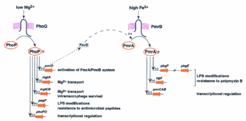Principles of two-component signal transduction
Signal transduction enables organisms to recognize changes in their environment and to convert this information into an appropriate response. In prokaryotes the conversion is often done by two-component systems (TCS), which may effect changes in gene transcription or swimming behavior of the organism.
In bacteria the most TCS are built up by one histidine kinase (HK) and one corresponding response regulator (RR). After detection of a signal, e.g. a change in the cell's redox status or the ion concentration in the medium, two HK monomers dimerize and phosphorylate a histidine residue in trans. Subsequently this phosphate group is transferred to an aspartate residue of the RR. As it was mentioned above, this short phosphorylation cascade (sketched in fig. 1) can aim on two different targets: the swimming behavior (via the CheA-CheY-system) and the gene expression pattern, respectively. An more detailed review about the basic features of TCS is given in West and Stock (2001).

The nature of the signals that can be detected by TCS is very widespread. A few examples are the responses of E. coli on phosphate starvation, potassium limitation or low osmotic pressure. Another also medical important group are TCS of human pathogens, who trigger a signalling cascade which lead to host infection. A comprehensive overview about the most known cases of signaling via TCS is given in the KEGG database under "Signal Transduction → Two-component system".
Some TCS are more sophisticated then the basic system described in the beginning. They comprise of a so called "hybridkinase", which not only consists of a kinase domain, but also a response regulator domain and an additional phosphorylatable histidine residue. These modified TCS are also called "phosphorelays". Because of two more phosphorylation events (see fig. 2), it is thought that these systems can integrate more signals into the signalling cascade and can better fine tuned. In prokaryotes phosphorelays are a minority in the TCS-family, whereas they are the major type of two-component systems found in eukaryotes. However, it shout be pointed out, that in higher eukaryotes no TCS are found at all. The structural differences between pro- and eukaryotic TCS and some ideas about their evolution can be found in Loomis et al. (1998) and Koretke et al. (2000).

In the last few years a more complex view of two-component signal transduction raised on the horizon. There are more and more working groups drawing a picture of cross talk activity between different TCS. One example from Salmonella is shown in fig. 3. One can imagine that the cross talk between TCS form a small regulatory network, which enables prokaryotic organisms to react on environmental changes in a well attuned manner.

References
-
West, A.H. and Stock, A.M. (2001) Histidine kinases and response regulator proteins in two-component signaling systems. Trends Biochem. Sci., 26, 369-376
-
Loomis, W.F., Kuspa, A. and Shaulsky, G. (1998) Two-component signal transduction systems in eukaryotic microorganisms. Curr. Opin. Microbiol., 1, 643-648.
-
Koretke, K.K., Lupas, A.N., Warren, P.V., Rosenberg, M. and Brown, J.R. (2000) Evolution of Two-Component Signal Transduction. Mol. Biol. Evol., 17, 1956-1970
-
Groisman, E.A. (2001) The Pleiotropic Two-Component Regulation System PhoP-PhoQ. J. Bacteriol., 183, 1835-1842.


